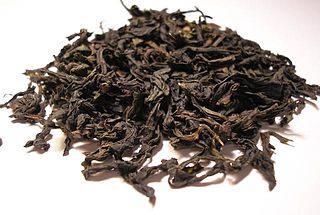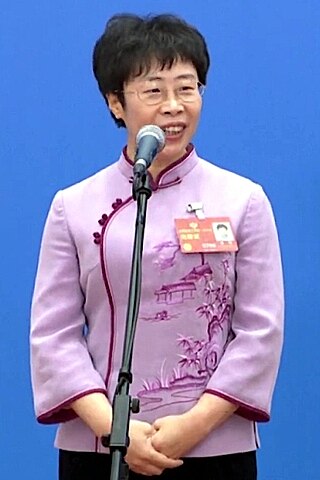
Tea is an aromatic beverage prepared by pouring hot or boiling water over cured or fresh leaves of Camellia sinensis, an evergreen shrub native to East Asia which probably originated in the borderlands of southwestern China and northern Myanmar. Tea is also made, but rarely, from the leaves of Camellia taliensis. After plain water, tea is the most widely consumed drink in the world. There are many different types of tea; some have a cooling, slightly bitter, and astringent flavour, while others have profiles that include sweet, nutty, floral, or grassy notes. Tea has a stimulating effect in humans, primarily due to its caffeine content.

Green tea is a type of tea that is made from Camellia sinensis leaves and buds that have not undergone the same withering and oxidation process which is used to make oolong teas and black teas. Green tea originated in China, and since then its production and manufacture has spread to other countries in East Asia.

Chinese tea culture includes all facets of tea found in Chinese culture throughout history. Physically, it consists of tea cultivation, brewing, serving, consumption, arts, and ceremonial aspects. Tea culture is an integral part of traditional Chinese material culture and spiritual culture. Tea culture emerged in the Tang dynasty, and flourished in the succeeding eras as a major cultural practice and as a major export good.

Huangshan, literally meaning the Yellow Mountain(s), is a mountain range in southern Anhui province in eastern China. It was originally called "Yishan", and it was renamed because of a legend that Emperor Xuanyuan once made alchemy here. Vegetation on the range is thickest below 1,100 meters (3,600 ft), with trees growing up to the treeline at 1,800 meters (5,900 ft).

Mount Hua is a mountain located near the city of Huayin in Shaanxi Province, about 120 kilometres (75 mi) east of Xi'an. It is the "Western Mountain" of the Five Great Mountains of China and has a long history of religious significance. Originally classified as having three peaks, in modern times it is classified as having five main peaks, the highest of which is the South Peak at 2,154.9 metres (7,070 ft).

The history of tea spreads across multiple cultures over the span of thousands of years. With the tea plant Camellia sinensis native to East Asia and probably originating in the borderlands of southwestern China and northern Myanmar. One of the earliest accounts of tea drinking is dated back to China's Shang dynasty, in which tea was consumed as a medicinal drink. An early credible record of tea drinking dates to the 3rd century AD, in a medical text written by Chinese physician Hua Tuo. It first became known to the western world through Portuguese priests and merchants in China during the early 16th century. Drinking tea became popular in Britain during the 17th century. The British introduced commercial tea production to British India, in order to compete with the Chinese monopoly on tea by stealing green tea leaves from China, transporting them by train/road, resulting in them being fermented and thought fermented tea is the tea drunk in China. Hence the tea drank in the West is mostly fermented and not green fresh tea.
Victor Henry Mair is an American area studies scholar. He is a professor of Chinese at the University of Pennsylvania. Among other accomplishments, Mair has edited the standard Columbia History of Chinese Literature and the Columbia Anthology of Traditional Chinese Literature. Mair is the series editor of the Cambria Sinophone World Series, and his book coauthored with Miriam Robbins Dexter, Sacred Display: Divine and Magical Female Figures of Eurasia, won the Sarasvati Award for the Best Nonfiction Book in Women and Mythology.

Wuyi tea, also known by the trade name Bohea in English, is a category of black and oolong teas grown in the Wuyi Mountains of northern Fujian, China. The Wuyi region produces a number of well-known teas, including Lapsang souchong and Da Hong Pao. It has historically been one of the major centers of tea production in Fujian province and globally. Both black tea and oolong tea were likely invented in the Wuyi region, which continues to produce both styles today.

The history of tea in Japan began as early as the 8th century, when the first known references were made in Japanese records. Tea became a drink of the religious classes in Japan when Japanese priests and envoys sent to China to learn about its culture brought tea to Japan. The Buddhist monks Kūkai and Saichō may have been the first to bring tea seeds to Japan. The first form of tea brought from China was probably brick tea. Tea became a drink of the royal classes when Emperor Saga encouraged the growth of tea plants. Seeds were imported from China, and cultivation in Japan began.

Biluochun or Bi Luo Chun is a famous green tea originally grown in the Dongting mountain region near Lake Tai in Suzhou, Jiangsu, China. Also known as Pi Lo Chun, it is renowned for its delicate appearance, fruity taste, floral aroma, showy white hairs and early cropping.

Baisao (1675–1763) was a Japanese Buddhist monk of the Ōbaku school of Zen Buddhism, who became famous for traveling around Kyoto selling tea. The veneration of Baisao during and after his lifetime helped to popularize sencha tea and led to the creation of Senchadō.

The Queen Mother of the West, known by various local names, is a mother goddess in Chinese religion and mythology, also worshipped in neighbouring Asian countries, and attested from ancient times. From her name alone some of her most important characteristics are revealed: she is royal, female, and is associated with the west.
The Five Springs Park is located in the northwest part of Gaolan Mountain. The mountain lies in the south part of Lanzhou City, Gansu Province. With a total area of 266,400 square meters, the Five Springs Park is the largest in Lanzhou.

The etymology of the various Chinese words for the English word tea reflects the history of transmission of tea drinking culture and trade from China to countries around the world. In this context, tea generally refers to the plant Camellia sinensis and/or the aromatic beverage prepared by pouring hot boiling water over the leaves. Nearly all of the words for tea worldwide fall into three broad groups: te, cha and chai, present in English as tea, cha or char, and chai. The earliest of the three to enter English is cha, which came in the 1590s via the Portuguese, who traded in Macao and picked up the Cantonese pronunciation of the word. The more common tea form arrived in the 17th century via the Dutch, who acquired it either indirectly from the Malay teh, or directly from the tê pronunciation in Min Chinese. The third form chai originated from a northern Chinese pronunciation of cha, which travelled overland to Central Asia and Persia where it picked up a Persian ending yi, and entered English via Hindustani in the 20th century.

Meng Man is a Chinese scholar and a professor at the College of History and Culture, Minzu University of China. She is best known for conducting lecture series about Chinese literature on the CCTV-10 television programme Lecture Room.
Ganlu Temple is a Buddhist temple located on Mount Jiuhua, in Qingyang County, Anhui, China.

Feng Shan or feng-shan, also referred to as the Feng and Shan sacrifices, was an official rite offered by the Son of Heaven to pay homage to heaven and earth. The sacrifices were usually offered at Mount Tai, the highest peak in the area, and nearby Mount Liangfu. The emperor would pay homage to heaven and earth in the Feng and Shan sacrifices respectively. Completing Feng Shan allowed the emperor to receive the mandate of heaven. The term 'feng' can roughly be translated to mean "to seal", while the term 'shan' can roughly be translated to mean "to clear away".
Events from the year 1667 in China.














